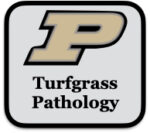Pervasive and disease conducive environment; newly grassed bentgrass green issues; basal rot anthracnose on Poa annua and creeping bentgrass; dollar spot and brown patch still rampaging; Lawn Care Diagnostic Training; New Zoysiagrass Field Day
Weather
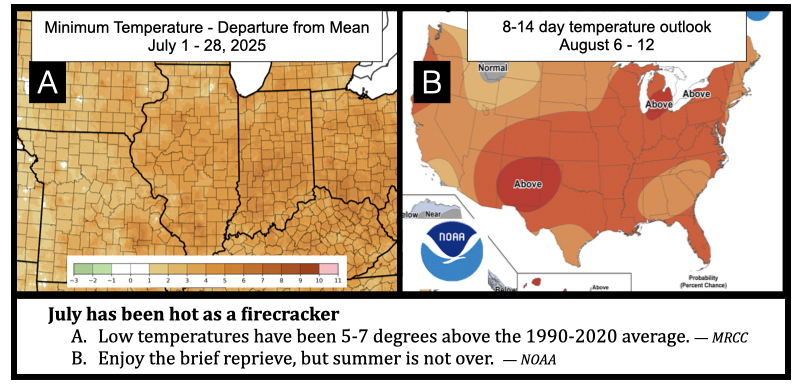
Like a boulder chasing down Indiana Jones, the stressful conditions of this summer have been relentlessly pursuing cool-season turfgrass health. July temperatures will end in the range of 4 – 7 degrees above average (1991-2020) for much of the state and region. Most of us have learned or become reacquainted with the concept of dew point (see a primer here)and associated real feel temperatures that have soared well above 100 F for much of the last two weeks. An interesting review in the Evansville Courier, puts the uniquely hot and humid summer into an overwhelmingly bleak perspective. Starting on July 14, dew points reached a “miserable” level of 75 F, starting a now 17-day streak with dewpoints at or above that mark, standing second Evansville’s weather history. Earlier floods, constant rains (9 days straight at one point), no cold fronts and corn sweat (an accurate term) have kept humidity at these high levels. The humidity is repressing the plants’ ability to transpire and cool itself, and high low temperatures aren’t providing a needed break at night. Water therefore isn’t removed from the soil and as stated in a previous report, when water gets hot it stays hot. Lastly, this free water is fuel for turfgrass diseases all too eager to take advantage of the compromised plant.
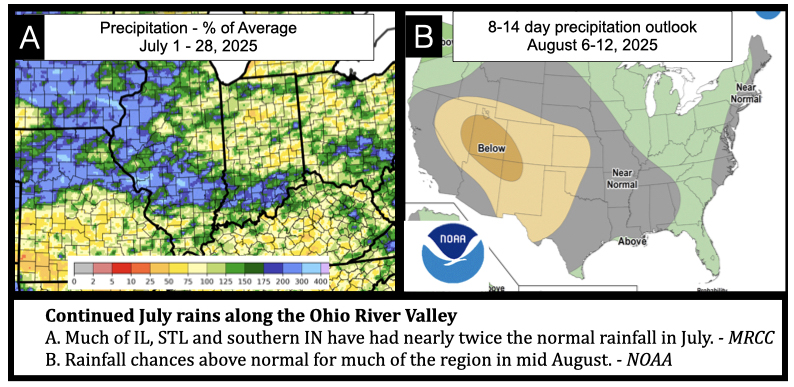
Short term fortunes have a cool front passing later this week, plunging temperatures back into the cooler 70s and 80s and importantly nighttime temperatures back into the 60s (and perhaps even high 50s). August is historically our second warmest month of the year, and the breather will be last only a few days, with summer heat and humidity set to resume into mid-August.
Golf: Young Bentgrass Green Troubles

Several samples from young (a few months to two-year-old) bentgrass greens have been submitted to the diagnostic lab over the last week. These young toddlers, like those in the animal world, are susceptible to a broader range of ills, presumably due to an underdeveloped immune system of the plant and an unprimed environment “immune system” that lacks the microbial diversity to fend off initial pathogen invaders. Additionally, a turfgrass system is made up of a community of plants, and over time some of the weaker plants that aren’t suited to the challenges of the environment are naturally selected out, either conspicuously or without notice.
One of these samples (shown above) was afflicted with both root knot nematodes and Pythium root dysfunction. Apart these two maladies are a problem but together can be devastating. Particularly if sodding new greens, conducting a nematode sampling after planting (or even better before from the sod purveyor) is advisable. This service isn’t currently offered at Purdue, but Missouri, Florida and several other institutions provide nematode analyses. In a recent survey of the region by my previous student Asa McCurdy, M.S., root-knot nematodes were found in high supply in Indiana and the surrounding region.
Pythium root diseases on golf putting greens come in two distinctly different flavors – Pythium root dysfunction and Pythium root rot. Pythium root rot is often present on older putting greens that have high organic matter content and do not drain well. On the other hand, Pythium root dysfunction is more often (but not always) a problem on newly established putting greens (< 5 -7 years old) and can occur on well drained greens. Pythium root dysfunction is caused by a more limited number of Pythium spp. than root rot, and results in a distinct symptom of tanned roots that almost completely lack root hairs. This symptom is so distinct that even moist sand from affected areas falls from a putting green core quite easily with minimum shake compared to healthy areas. Pythium root dysfunction also can appear as a patch symptom and operates a bit more akin to a patch disease, with distinct infection periods in the spring and fall, making preventive applications during those periods crucial.
Fungicide treatments for these two diseases were quite different since the involved Pythium spp. had different sensitivities and efficacy varied. Fortunately, picarbutrazox (Serata) and cyazofamid (Segway) have demonstrated good efficacy on a more diverse range of Pythium spp. and are effective for managing these diseases. As an added bonus, the two fungicides also represent two different modes of action, so should be effective resistance management tools for each other.
Basal Rot Anthracnose on Putting Greens – Reports & Warning
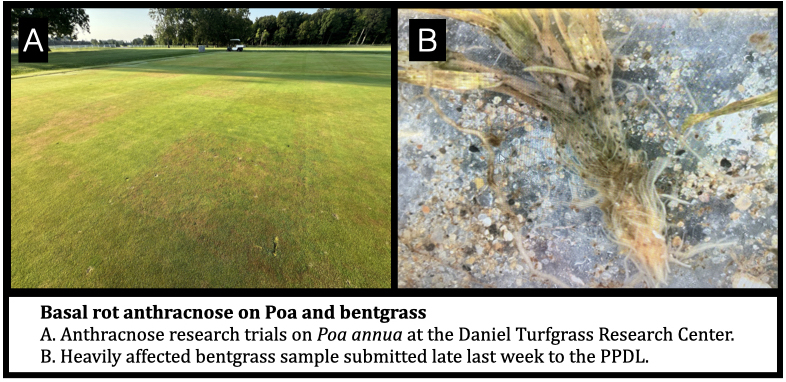
A sample of basal rot anthracnose from a bentgrass putting green was observed last week, and in our current trials on annual bluegrass, the disease is exceptionally severe. This disease, caused by Colletotrichum cereale, can take two forms – a chlorosis inducing foliar symptom and the now more damaging crown and basal rot. The latter of the two is in full force now and should continue into early fall.
In my experience, basal rot anthracnose cases are often sparked in my experience by a sudden temperature drop after a high heat stress period, a scenario set to arrive. My theory for this influx of disease activity stems from anthracnose being a low nitrogen disease. The plant system is stressed from the environment, roots are not functioning at their prime, and yet the cooler temperatures spark it into growth mode. Nitrogen may not be available because of low spoon feeding rates and the plant presumably can’t take it up effectively even if it is. Anthracnose takes advantage and dives into the crown.
Suggested curative fungicides center on QoI plus “cool DMI” combinations including Navicon, Ascernity and Briskway with Velista and Densicor also having good activity. Also as a note of warning, don’t go crazy with agronomic practices such as intense verticutting during this transient temperature reprieve. This disease along with a myriad of other problems can result from pushing the plant too far when in this weakened state.
Lawns – Brown patch and dollar spot still on the rampage
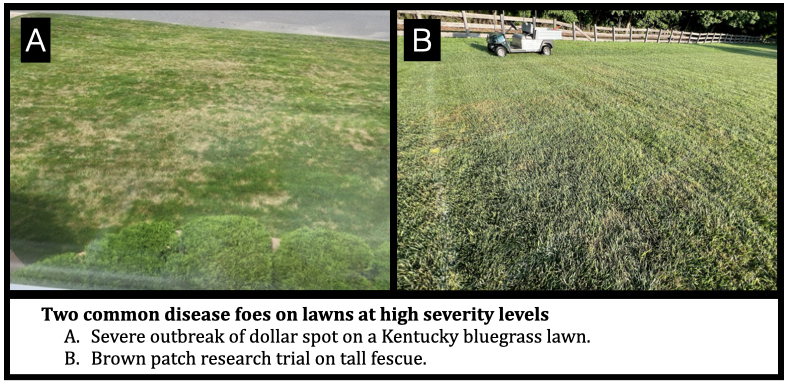
As noted in the last report, dollar spot on Kentucky bluegrass and brown patch on tall fescue have been frequent visitors to the diagnostic lab, and are raging through lawns, golf course roughs, commercial properties, etc. Identifying these two diseases is made easier by identifying the host. I have never observed dollar spot on tall fescue and brown patch occurs on a rare few varieties of Kentucky bluegrass (‘HGT’, however, being one of them). Getting the identification of these diseases right is important, as the strobilurins (i.e. azoxystrobin and pyraclostrobin) are not effective for dollar spot control and many of the fungicides effective for dollar spot control do a poor job controlling brown patch.
Timing of fungicides can reduce the number of needed applications if done correctly. At this past field day, we presented a demonstration plot with a standard application scheme, preventive timing and curative timing for azoxystrobin applications targeting brown patch control. We will discuss these observations and more at the Lawn Care Diagnostic Training event noted below.
Lawn Care Diagnostic Training – August 14
Join Drs. Patton, Bigelow, Powlen and myself for this year’s iteration of the Lawn Care Diagnostic Training. The morning program will have traditional presentations with the afternoon session being rotating field demonstrations concerning irrigation, weed control and disease control. Each participant will get print copies of both the updated Professional Weed Control for Turfgrass Managers and the Common Diseases on Cool-Season Lawns guides.
For more information and to register for this event, click here.
The very next week Purdue will be hosting a unique event focusing solely on zoysiagrass genetics and maintenance on August 19 at the Daniel Turfgrass Center. This field day will feature various university scientists discussing the current and future status of zoysiagrass use here, throughout the country and world. Presenters include the Purdue team, Drs. Ambika Chandra from Texas A&M University, Susana Milla-Lewis from North Carolina State University, Brian Schwartz from University of Georgia and more!
For more information and to register for this event, click here.
Extension Turfgrass Pathologist – Purdue University
Follow on Twitter: @purdueturfpath

